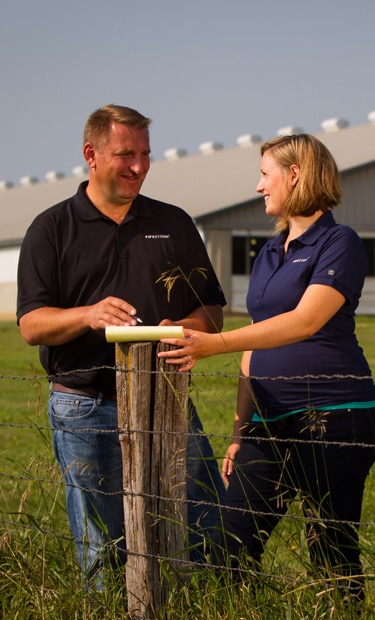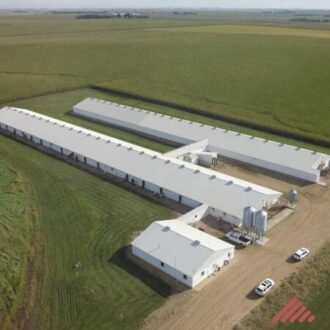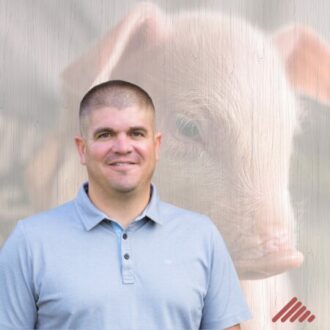Effective ventilation is one of the most critical factors in maintaining a healthy and productive swine operation. It influences air quality, temperature control, and the overall environment for the pigs. However, achieving the right balance in ventilation comes with its challenges, especially when factoring in barn design, fan efficiency, and climate conditions.
Precision in managing airflow, temperature, and humidity is vital. Dr. Blythe shares, “I always carry an anemometer and an infrared gun to measure airspeed and temperature. These tools can help identify potential issues before they become major problems.”
Additionally, monitoring equipment placement is just as crucial: “Probe placement can make or break your barn’s environment. If probes are taking on air straight out of the inlets, or directly from a heater it can make the barn seem cooler or hotter than it really is.”
Common Ventilation Challenges
- Inconsistent Airflow: Poor airflow can lead to areas of the barn with stagnant air or high humidity, which are breeding grounds for pathogens like bacteria and viruses.
- Temperature Control Issues: Proper temperature control is essential, especially since pigs’ comfort can be impacted by even small fluctuations.
- Humidity Problems: High humidity in the barn can exacerbate respiratory issues and provide a fertile environment for disease. Low humidity, on the other hand, can lead to excess dust, dehydration, and stress in pigs.
- Fan Degradation: Over time, fans can lose efficiency due to dirt, debris, and general wear, making it harder to maintain consistent airflow and adequate ventilation. Functional equipment is paramount
Addressing Ventilation Challenges
- Probe Placement and Monitoring
Proper probe placement is vital. If the temperature probes are placed in direct line to an air inlet or heater, the controller might read a lower or higher temperature than the pigs are experiencing. This results in a suboptimal environment and potential discomfort for the pigs. “We found probes placed right between inlets,” Enfield recalls. “The probes were reading much cooler temperatures than the actual barn temperature because they were getting air directly from those inlets, while the pigs were much warmer. You want to be making ventilation decisions for where the pigs are, not where the air is coming in,” Blythe stresses.
- Maintaining Fan Efficiency
Fan efficiency is a recurring issue in barns, especially when dirt and manure accumulate on the equipment. The efficiency of tunnel fans can degrade by as much as 15%, while pit fans can lose about 10% efficiency due to dirt buildup and wind resistance. “We take the book value of the fan’s cubic feet per minute (CFM), then multiply it by 90% twice to get a more accurate real-world value,” Enfield explains.The role of outside cones on tunnel fans is also highlighted. These cones help create a shaft of air, improving airflow efficiency. Without them, a fan can lose up to 15% of its capacity. Over time, cones can crack and wear out, so regular maintenance or replacement is necessary to keep the system functioning optimally. A good practice is to make sure fan louvers get washed between turns, and when weather allows, to power wash pit fans to ensure optimal performance.
- Calculating by pig size and seasonality
Determining the correct ventilation rate based on pig size & seasonality is critical for ensuring a healthy environment. The minimum cold weather rule of thumb is 2 CFM per pig for weaned pigs. “For a 1,000-head room, you’d need around 2,000 CFM of air moving through the barn. Knowing your fan size and output helps ensure you hit that target,” Enfield explains.As pigs grow, the ventilation needs to increase. A 30-pound pig might require about three CFM, while a 50-pound pig would need around five CFM. It’s essential to scale ventilation to match the pigs’ weight and weather to avoid issues such as under-ventilation, which leads to high humidity, or over-ventilation, which can result in drafts and increased energy costs.
- Managing Humidity Levels
Humidity is a major concern in swine barns. Dr. Blythe advises maintaining humidity between 40% and 60%, with 50% being the ideal target. High humidity not only increases the risk of bacterial growth but also contributes to respiratory problems in pigs. “When humidity starts creeping above 70%, you need to intervene,” he warns. “If it hits 80% or higher, the environment becomes really conducive to bacterial and viral growth, leading to poor respiratory health.”“A damp pig is a sign that conditions need to be addressed for the health of your pigs, your caretakers, and your facility.”
- Monitoring Pig Behavior
Pig behavior is one of the most reliable indicators of proper ventilation. If pigs are piling up, it’s a sign that they’re not comfortable, regardless of what the thermometer says. Let the pigs and the environment guide your adjustments. Walk through the barn, observe how the pigs lay, their movement, and any signs of discomfort, then assess how it feels—whether it’s too humid or gassy—making time for sensory observation is a vital exercise.
- Airspeed Control & Inlet Management
Proper airspeed ensures the ventilation benefits the pigs without creating drafts or dead zones. “You don’t want the air coming out of the inlets too fast or too slow,” Enfield notes. “If it’s too fast, you’ll create drafts that stress the pigs. If it’s too slow, the air will drop straight down and won’t circulate properly.” Target 800-1,000 feet per minute (fpm) for power ventilation stages. A realistic target for barns operating in minimum ventilation (below set point) is 300-600 fpm.
- Dealing with Cold Weather Ventilation
Cold weather presents a unique set of ventilation challenges. “In cold weather, you want your minimum fan (stages 1 & 2) ventilation bandwidths a bit wider (1.5°-2°) with a 0.5-degree offset,” Dr. Blythe advises. “That way, you’re controlling airflow without creating huge temperature swings.” In colder climates, it’s easy to unde-ventilate in an effort to save on heating costs, but this can lead to high humidity and poor air quality.
By addressing these common challenges—through regular maintenance, probe placement, and a focus on air quality—farmers can significantly improve their barn environments. Effective ventilation not only boosts pig health but also improves farm productivity and profitability.












